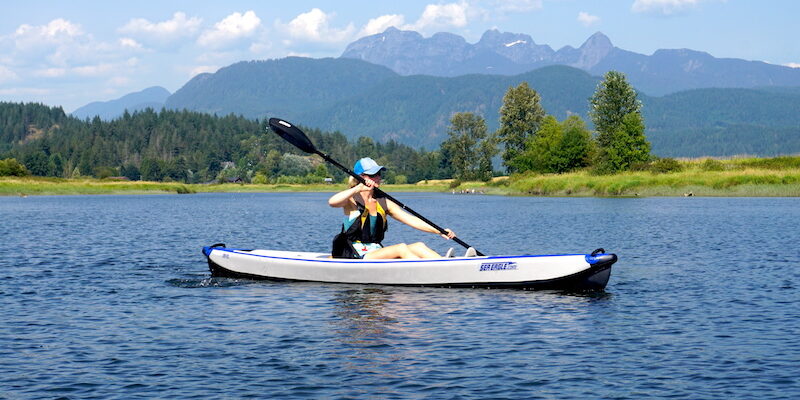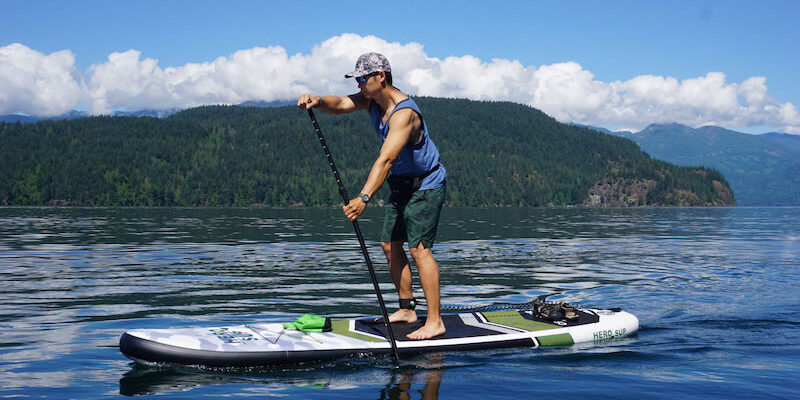Whether your kayak is an inflatable kayak or a hard-shell kayak it will likely have the option for either a rudder or a skeg.
A rudder is used for steering but a skeg is simply used to help keep your kayak straight with minimal effort.
There are other specifics that are also important to know so that you get the optimum performance from your kayak.
Below we will describe important facts to know about using a kayak skeg.
Using a Kayak Skeg
The most important reason to use a skeg is to keep your kayak on track with hopefully less effort from you.
It can make the kayak much easier to handle and much calmer for paddling.
The skeg is most useful when kayaking in wind and/or waves… especially when paddling with the wind while the waves are coming from the side.
If there is no wind or waves then your kayak will not likely have any trouble keeping straight and the skeg does very little.
When do you need to use the skeg?
Weather And Water Conditions
Different models of kayaks will be affected differently from the wind and from waves.
Some models can handle weather conditions much better while others will absolutely need the skeg to keep the kayak straight.
With a little research on your kayak you will be able to know fairly quickly how well it handles the elements. Typically inflatable kayaks will always need a skeg in wind.
Kayak Load
The need of a skeg can also have to do with how your kayak is loaded.
For example if the stern of your kayak is being more affected by the wind than the bow, by rearranging the load of the kayak so that it is heavier in the stern it will become more equal to the bow and therefore allow your kayak to be less affected by the wind even without a skeg.
Understanding how and why your Kayak is Reacting to the Elements
If the wind is turning your kayak while you are moving forward with speed then it is because the stern of your kayak is moving sideways as compared to the bow.
From where you are sitting it will seem as though your kayak is turning towards the wind (i.e. the problem will seem to be with the bow).
However in reality the problem is that the stern is skidding in the water in the same direction of the wind much more so than the bow. Therefore you need to use your skeg to stop the skidding from the stern.
How the loading of your kayak will affect the kayaks course
How you load your kayak will directly affect how it maneuvers in the wind and waves as well as how effective your skeg will be.
1. If you have loaded your kayak so that the rear of the boat is heavier than the front, then the stern (rear) will have more sideways resistance to the wind.
When this happens the bow (front) of your kayak will have less sideways resistance and it will likely point with the wind.
2. If you have loaded your kayak so that the front is heavier than the rear then the front will have more sideways resistance to the wind and the rear will have less sideways resistance.
Your kayak will react by pointing into the wind.
Ideally if you are dealing with harsh elements you will want your kayak loaded with more weight from the center down.
In other words less weight up front.
By using your skeg you can add sideways resistance to the back of your kayak which allows the front to have less resistance and will help you to paddle with the wind as opposed to paddling up wind.
Even if your kayak handles different weather conditions with ease a skeg can still be very useful in guiding your kayak as well as help reduce the amount of effort you must put forth, which is always a good thing.
To learn more about maneuvering your kayak take a look at the beginner paddling techniques that are a “must learn” for all new kayakers.


Just tried my Tomahawk 375 . A bit wobbly and I’m a real beginner .have a spare skeg how about adding a bit of a weight help lower centre of gravity .Less wobbly ?
Sorry, as a beginner, coudn’t follow your logic – would you please elaborate? “If … the rear of the boat is heavier than the front, then the stern (rear) will have more sideways resistance to the wind. … If … the front is heavier than the rear then the front will have more sideways resistance to the wind and the rear will have less sideways resistance.” Why? If the weight, like a heavy bad dropped on the floor, does not protrude much over the original silhouette of the kayak, I would expect just the opposite: whichever part of the kayak is heavier, stern or bow, it would sit deeper in the water and have less exposure to the wind over the waterline. The combined effects of decrease windage and increased resistance to any lateral movement from the water for a heavier part of the kayak (as compared to a lighter part) will make lighter part to point with the wind and heavier part to point into the wind – directly opposite to the way you described. What exactly am I missing?